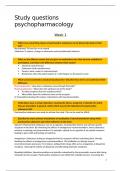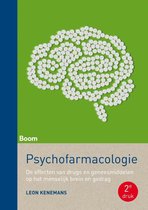Summary
Summary Psychopharmacology- Study questions and answers
- Course
- Institution
- Book
This document contains the study questions and answers for the course Psychopharmacology (), University Utrecht. The answers are based on the lectures, Kenemans, Psychopharmacology 2th edition (ISBN: 2128) & Lawrence, Labbate et al. Handbook of Psychiatric Drug Therapy (ISBN 978-07-8177-486-4).
[Show more]




